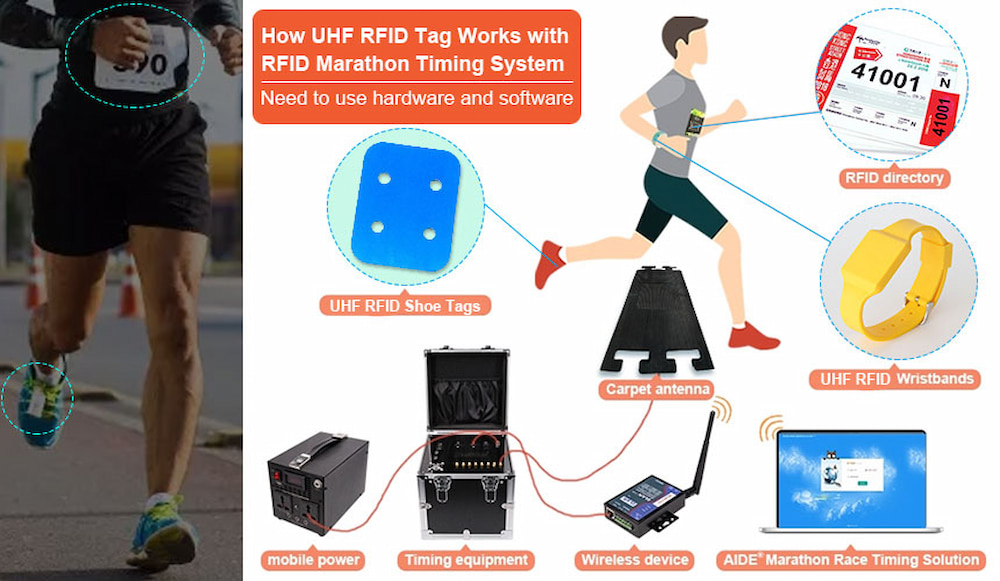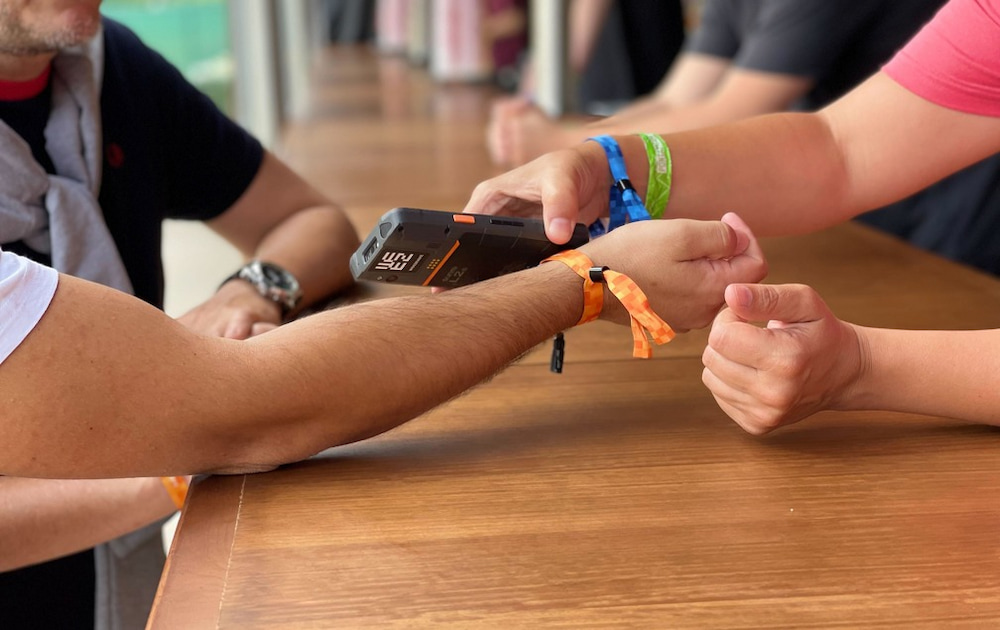
تعمل الأندية ومنظمو الفعاليات، أصحاب الرؤى المستقبلية، على تحويل تجربة المشجعين إلى تجربة سلسة وتفاعلية وشخصية للغاية. تتناول هذه المقالة كيفية عمل تقنية تحديد الهوية بموجات الراديو (RFID) في النظام البيئي الرياضي. سنتجاوز الأساسيات، مستكشفين تطبيقاتها العملية، وعائد الاستثمار الملموس، والاعتبارات التكنولوجية الكامنة وراء تطبيقها.
إحداث ثورة في تجربة المشجعين: من الدخول إلى الخروج
يكمن التأثير الأبرز لتقنية تحديد الهوية بموجات الراديو (RFID) في تجربة المشجعين. فهي تُعالج نقاط الضعف الشائعة وتُتيح فرصًا جديدة للتفاعل.
التحكم في الوصول بشكل سلس وآمن
ولّت أيام البحث عن التذاكر الورقية. يستطيع المشجعون دخول القاعة بلمسة بسيطة باستخدام سوار معصم مزود بتقنية RFID أو بطاقة.
سرعة: وفقًا لدراسة حالة أجرتها شركة ASM Global، تستطيع بوابات RFID معالجة ما يصل إلى 20 مروحة في الدقيقة، مقارنةً بـ 4-6 مروحة فقط في الدقيقة لمسح الباركود التقليدي. هذا يُقلل بشكل كبير من أوقات الانتظار والازدحام.
حماية: علامات RFID يصعب نسخها، مما يقلل من خطر تزوير التذاكر. في حال فقدان البطاقة أو سرقتها، يُمكن إلغاء تفعيلها فورًا.
ثورة تناول الطعام بدون نقد
تُشكّل الطوابير الطويلة أمام أكشاك الطعام مصدرًا رئيسيًا لإحباط المشجعين. تُتيح تقنية تحديد الهوية بموجات الراديو (RFID) نموذج دفع غير نقدي تمامًا.
كفاءة: يمكن للمشجعين تحميل أساور RFID مسبقًا أو ربطها ببطاقاتهم الائتمانية. لمسة بسيطة تُكمل العملية في ثانيتين.
البيانات والمبيعات الإضافية: أعلن فريق أورلاندو ماجيك عن زيادة بنسبة ٢٣٪ في متوسط إنفاقه على الطعام والمشروبات بعد تطبيق نظام الدفع الإلكتروني (RFID). وتشجع الخدمة السريعة على زيادة الإنفاق بشكل متكرر.
تفاعل مُحسَّن وتجارب مُخصَّصة
تُحوّل تقنية تحديد الهوية بموجات الراديو (RFID) المشاهدين المجهولين إلى زوار معروفين. تُعدّ هذه البيانات موردًا تسويقيًا قيّمًا.
المنطقة التفاعلية: ويستطيع المشجعون استخدام أساور المعصم الخاصة بهم في أكشاك الخدمة الذاتية للتصويت على "لاعب الأسبوع"، أو المشاركة في الألعاب، أو تفعيل التجارب التي يوفرها الرعاة.
العروض الشخصية: إذا كان المعجبون يشترون البيرة باستمرار، يمكن للنظام إرسال إشعارات فورية إلى هواتفهم تعرض خصومات على مشترياتهم التالية. هذا النهج التسويقي المُستهدف أكثر فعالية بكثير من العروض الترويجية الشاملة.
القوة التشغيلية: تبسيط إدارة الملعب والفريق
في حين يرى المشجعون الفوائد الأمامية، فإن الكفاءات التشغيلية الخلفية تكون تحويلية بنفس القدر.
إدارة المخزون والأصول المتقدمة
تُعد الملاعب عمليات معقدة تتضمن آلاف الأصول، بدءًا من معدات تقديم الطعام وحتى البضائع بالتجزئة.
الرؤية في الوقت الحقيقي: علامات RFID السلبية تسمح أنظمة قراءة البيانات الموجودة على البراميل أو الزي الرسمي أو معدات السمعية والبصرية للموظفين بتحديد موقع العناصر على الفور باستخدام أجهزة قراءة محمولة، مما يقلل من الخسائر ويوفر ساعات العمل.
منع السرقة: قام أحد أكبر أندية كرة القدم الأوروبية بتنفيذ تقنية تحديد الهوية بموجات الراديو في متاجره بالتجزئة وشهد انخفاضًا بنسبة 17% في انكماش المخزون خلال الموسم الأول، مما أدى إلى تعزيز الربحية بشكل مباشر.
تحسين سير عمل الموظفين والأمن
تتيح شارات RFID النشطة للموظفين وأفراد الأمن تنسيقًا أفضل واستجابة أفضل للطوارئ.
تتبع الموقع: يمكن لمديري العمليات رؤية الموقع الفعلي لفرق الأمن وفرق التنظيف والموظفين الطبيين، مما يسمح بالنشر الديناميكي حيث هم في أمس الحاجة إليهم.
سلامة الطفل: بعض الأماكن المناسبة للعائلات تقدم أساور RFID للأطفال المرتبطين بتذكرة أحد الوالدين. هذا يُساعد على لمّ شمل الأطفال المفقودين مع عائلاتهم بسرعة وأمان.

في الملعب: ميزة الأداء والبث
ويمتد تأثير تقنية تحديد الهوية بموجات الراديو إلى ما هو أبعد من المدرجات ليصل إلى ميدان اللعب، حيث تعمل على توفير البيانات التي تعمل على تعزيز الأداء ورواية القصص.
تتبع اللاعبين والتحليلات
قامت رابطة كرة القدم الأمريكية الوطنية (NFL) بدمج شرائح RFID الخاصة بشركة Zebra Technologies في كرات القدم ووسادات أكتاف اللاعبين منذ عام 2014. وهذا يوفر سيلًا من البيانات في الوقت الفعلي.
المقاييس الرئيسية: يلتقط النظام بيانات دقيقة عن سرعة اللاعب، والمسافة المقطوعة، والتسارع، والتباطؤ. على سبيل المثال، يمكنه قياس وصول لاعب استقبال واسع إلى سرعة قصوى تبلغ 21.5 ميلاً في الساعة عند استقبال الكرة.
الوقاية من الإصابات: تُحلل الفرق هذه البيانات لمراقبة عبء تدريب اللاعبين. من خلال تتبع إجمالي المسافة المقطوعة أثناء التدريب، يستطيع علماء الرياضة تحديد مستوى التعب وتقليل خطر إصابات الأنسجة الرخوة.
إثراء تجربة البث والشاشة الثانية
بيانات تتبع اللاعبين والكرات ليست مخصصة للمدربين فحسب، بل تُرسل فورًا إلى شركاء البث.
التحسينات البصرية: يستطيع المذيعون عرض رسومات بيانية توضح سرعة اللاعب، أو معدل دوران كرة البيسبول، أو إنشاء "مثلث التمرير" في كرة القدم.
مشاركة المعجبين: تستخدم رابطة كرة السلة الأميركية NBA بيانات التتبع الخاصة بها لتشغيل إحصائيات متقدمة على موقعها الإلكتروني وتطبيقها، مما يسمح للمشجعين بالتعمق في أداء اللاعبين والفرق بشكل لم يسبق له مثيل من قبل.
قياس النجاح: العائد الحقيقي على الاستثمار من تطبيق تقنية تحديد الترددات الراديوية (RFID)
يُعدّ اعتماد تقنية تحديد الهوية بموجات الراديو استثمارًا هامًا. ويجب أن تُبنى قيمته التجارية على عوائد مالية واضحة ومزايا استراتيجية.
نمو الإيرادات المباشرة
إن العلاقة بين تقنية تحديد الهوية بموجات الراديو ونمو المستهلك موثقة جيدًا.
زيادة الإنفاق على الامتياز: وكما أظهرت تجربة فريق أورلاندو ماجيك، فإن راحة الدفع غير النقدي تؤدي بشكل مباشر إلى زيادة متوسط قيمة المعاملة.
مبيعات التجار: تساهم سرعات الدفع الأسرع والقدرة على تقديم خصومات مخصصة في متاجر الفريق في زيادة مبيعات البضائع.
استثمار البيانات: تعتبر بيانات سلوك المشجعين المجمعة والمجهولة المصدر أمرًا بالغ الأهمية لتأمين وتبرير صفقات الرعاية مع العلامات التجارية.
انخفاض كبير في التكلفة
تعمل تقنية RFID على تحسين الكفاءة، وبالتالي تقليل تكاليف التشغيل بشكل مباشر.
انخفاض تكاليف العمالة: يتم الحاجة إلى عدد أقل من الموظفين عند المداخل والأكشاك بسبب زيادة إنتاجية أنظمة RFID.
تقليل خسائر الاحتيال: يؤدي تقليل عمليات الاحتيال في التذاكر وخسائر المخزون إلى حماية تدفقات الإيرادات.
تحسين الكفاءة التشغيلية: يؤدي تقليل وقت البحث عن الأصول إلى انخفاض تكاليف العمالة وتخصيص الموارد بكفاءة أكبر.

دراسة حالة: تطبيق RFID في الاتحاد الألماني لكرة القدم (DFB)
لقد وضع الاتحاد الألماني لكرة القدم مثالاً عالميًا من خلال تنفيذ تقنية تحديد الهوية بموجات الراديو (RFID) في جميع أنظمته البيئية، بما في ذلك مسابقات المنتخبات الوطنية والأندية.
نظام تحديد هوية المروحة: شجع الاتحاد الألماني لكرة القدم استخدام تقنية تحديد الهوية بموجات الراديو لإنشاء نظام تعريف للمشجعين كطريقة أساسية لدخول المباريات والدفع.
نتائج: حقق النظام معدل دفع إلكتروني تجاوز 85%. والأهم من ذلك، أنه وفّر بياناتٍ لا مثيل لها حول نشاط المشجعين وتفضيلاتهم، مما أتاح إطلاق حملات تسويقية مُستهدفة للتذاكر والسلع المستقبلية.
رؤى استراتيجية: ويوضح نجاح الاتحاد الألماني لكرة القدم أن تقنية تحديد الهوية بموجات الراديو ليست مجرد أداة دخول تكتيكية، بل هي منصة استراتيجية لبناء علاقات طويلة الأمد مع المشجعين ونماذج إيرادات مستدامة.
دليل تنفيذ نظام تحديد الهوية بموجات الراديو: دليل عملي
يتطلب نجاح تطبيق تقنية تحديد الهوية بموجات الراديو (RFID) تخطيطًا دقيقًا. قد يؤدي التسرع في التنفيذ إلى أعطال فنية ومعارضة شديدة من جانب المعجبين.
الخطوة 1: حدد أهدافك
أولاً، حدد نقاط ضعفك الرئيسية. هل هي طوابير الانتظار الطويلة عند بدء التشغيل؟ بطء المبيعات؟ نقص بيانات العملاء؟ ستحدد أهدافك اختيارك للتكنولوجيا (سلبية أو نشطة) وحجم مشروعك.
الخطوة 2: اختيار الشريك التكنولوجي المناسب
اختر موردًا يتمتع بخبرة واسعة في الفعاليات العامة واسعة النطاق. يجب أن يوفر أجهزة قوية، ومنصة برمجيات موثوقة، ودعمًا شاملًا.
الأسئلة الرئيسية: ما مدى ضمانكم لفعالية النظام؟ كيف تحافظون على خصوصية البيانات؟ هل يمكنكم تقديم دراسات حالة من عملاء رياضيين آخرين؟
الخطوة 3: البنية التحتية والتكامل
عادةً ما تُبنى الملاعب الرياضية من المعدن والخرسانة، وهما موادّ قد تتداخل مع موجات الراديو. يُعدّ إجراء مسح احترافي للموقع أمرًا بالغ الأهمية لضمان تركيب أجهزة القراءة بشكل صحيح وتحقيق تغطية شاملة.
العوامل الرئيسية: تأكد من تكامل نظام تحديد الهوية بموجات الراديو (RFID) الجديد بسلاسة مع برنامج التذاكر ونقاط البيع وإدارة علاقات العملاء (CRM) الحالي لديك. فوجود مخازن بيانات منفصلة قد يؤثر سلبًا على عائد استثمارك.
الخطوة الرابعة: خطة التواصل مع المعجبين
جمهورك هو عميلك. يتطلب إطلاق النظام الجديد تواصلًا واضحًا واستباقيًا.
خطة العمل: استخدم البريد الإلكتروني ووسائل التواصل الاجتماعي ولافتات الملاعب لشرح مزايا النظام الجديد للجماهير (مثل سرعة الدخول وسهولة الدفع) وكيفية استخدامه. فتجربة استخدام سلسة وسلسة هي مفتاح النجاح.
الخاتمة: استراتيجيات الفوز في عصر الرياضة الحديث
توفر تقنية تحديد الهوية بموجات الراديو فوائد ثلاثية للرياضات الحديثة: توفير تجربة لا مثيل لها للجماهير، وتوفير كفاءة تشغيلية كبيرة للأماكن، وتزويد الفرق بمجموعة كبيرة من بيانات الأداء.
إن المنظمات التي تتبنى تقنية تحديد الهوية بموجات الراديو لا تفعل أكثر من مجرد بيع التذاكر؛ بل إنها تبني علاقات أعمق تعتمد على البيانات مع المشجعين، وبالتالي ضمان ولاء المشجعين ونمو الإيرادات لسنوات قادمة.

الدردشة الآن
مسح ضوئي إلى WeChat :

مسح ضوئي إلى WhatsApp :
